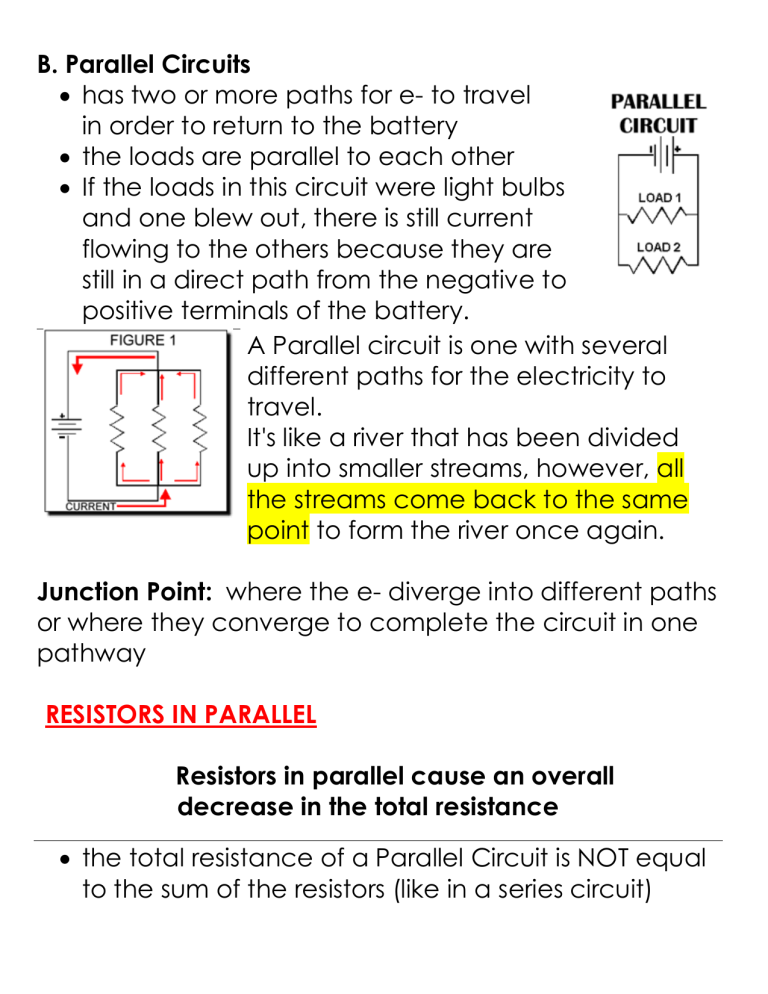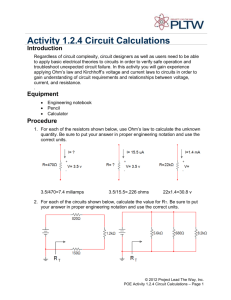Parallel Circuits: Understanding Electricity Flow

B. Parallel Circuits
has two or more paths for e- to travel in order to return to the battery
the loads are parallel to each other
If the loads in this circuit were light bulbs and one blew out, there is still current flowing to the others because they are still in a direct path from the negative to positive terminals of the battery.
A Parallel circuit is one with several different paths for the electricity to travel.
It's like a river that has been divided up into smaller streams, however, all the streams come back to the same point to form the river once again.
Junction Point: where the e- diverge into different paths or where they converge to complete the circuit in one pathway
RESISTORS IN PARALLEL
Resistors in parallel cause an overall
decrease in the total resistance
the total resistance of a Parallel Circuit is NOT equal to the sum of the resistors (like in a series circuit)
current entering a parallel circuit must divide among the possible paths
the resistance of a circuit is a measure of how much the circuit resists the flow of e-
adding more parallel resistances to the paths causes the total resistance in the circuit to decrease.
as you add more and more branches to the circuit the total current will increase because Ohm's Law states that the lower the resistance, the higher the current. V=IR
The total resistance in a parallel circuit is always less than any of the branch resistances.
CURRENT IN PARALLEL
As you add more and more branches to the circuit, the total current will increase . Why?!
Remember from Ohm’s Law that the lower the resistance, the higher the current:
I = V so if the voltage is 120 V, let’s see how current
R changes as resistance goes down:
120 V = 12A 120 V = 24 A 120 V = 120 A
10 Ω 5 Ω 1 Ω
Think of a supermarket check-out: if there is a long lineup at one cashier, they open more lines so that everyone can move through more quickly and easily
VOLTAGE IN PARALLEL
Voltage remains the same through each pathway of the parallel circuit
Each e- entering the junction point of a parallel circuit possesses the same energy
Individual e- can take only one of the pathways and then rejoins with the rest of the e- at the junction where the branches unite.
Regardless of the pathway, the e- transfers the same amount of energy.
Therefore, each pathway in the circuit loses all the battery potential its e- came in with
BASIC RULES FOR PARALLEL CIRCUITS
1.
A parallel circuit has two or more paths for current to flow through.
2.
Voltage is the same across each component of the parallel circuit.
3.
The sum of the currents through each path is equal to the total current that flows from the source.
4.
You can find TOTAL RESISTANCE in a Parallel circuit with the following formula:
1 = 1 + 1 + 1 + ... (this isn’t as hard as it
RT R1 R2 R3 looks!)
5.
If one of the parallel paths is broken, current will continue to flow in all the other paths.
1. "A parallel circuit has two or more paths for current to flow through."
Simply remember that PARALLEL means two paths up to thousands of paths! The flow of electricity is divided between each according to the resistance along each route. e- will choose the “easiest” route!
2. "Voltage is the same across each component of the parallel circuit."
Remember that the voltage drops across each load in series. Not so with a parallel circuit. The voltage will be the same anywhere in the circuit.
3. "The sum of the currents through each path is equal to the total current that flows from the source."
If one path is drawing 1 amp and the other is drawing 1 amp then the total is 2 amps at the source.
If there are 4 branches in this same 2 amp circuit, then one path may draw 1/4A (.25A), the next 1/4A (.25), the next 1/2A (.5A) and the last 1A.
Don't worry, the next rule will show you how to figure this out.
Simply remember for now:
that the branch currents must be equal to the
source current.
4. "You can find TOTAL RESISTANCE in a Parallel circuit with the following formula: 1/RT = 1/R1 + 1/R2 + 1/R3 +
... "
Before we get into the calculations, remember what we said at the start of this section: "The total resistance of a parallel circuit is NOT equal to the sum of the resistors (like in a series circuit).
We will use a parallel circuit with 3 paths as an example (it could be 2, 4 or a 1000 resistors in parallel). The power source is providing 12 volts and the value of the resistors are 5
Ohms, 5 Ohms and 2 Ohms.
Let's summize this EXAMPLE:
Voltage = 12V
R1 = 5 Ohm
R2 = 5 Ohm
R3 = 2 Ohm
Remember that "Rt" means Total resistance of the circuit.
R1, R2, etc. are Resistor one, Resistor two, etc.
Now we will apply the formula above to this example:
1
—
- =
Rt
1
—
- +
R1
1
—
- +
R2
1
—
-
R3
Therefore:
1
—
- =
Rt
1
—
- +
4
1
—
- +
4
1
—
-
2
It is easiest to change the fractions into decimal numbers (example 1 divide by 4 equals .25):
1/Rt = .25 + .25 + .5
1/Rt = 1
Now you have to get rid of the 1 on the left side so...
Rt = 1/1
Rt = 1 Ohms
NOW, Let's try a more complex one:
Voltage = 12 Volts
R1 = 10 Ohms
R2 = 20 Ohms
R3 = 10 Ohms
R4 = 1 Ohms
1/Rt = 1/10 + 1/20 + 1/10 + 1/1
1/Rt = .1 + .05 + .1 + 1
1/Rt = 1.25
Rt = 1/1.25 = .8 Ohms
Before we move on to the last rule here's how easy it is to calculate the amperage through each path using
OHM'S LAW.
In the example we see a 12 and 24 ohm resistor in parallel with a 12 volt source. First we figure out the total resistance of the circuit:
1/Rt = 1/12 + 1/24
Rt = 7.69 Ohms
Now that you know this you = 1.5
Amps
Therefore the total amperage between the two resistive paths must equal 1.5 Amps (Rule 3). Now we can figure out exactly what each path is pulling using Ohm's Law once more. Remember that the voltage is the same everywhere in a parallel circuit. So we know the voltage and the resistance:
I1 = 12V / 12 Ohm = 1 A
I2 = 12V / 24 Ohm = .5 A
We figured the total amperage (It) previously, so now we can double check if the figures are correct:
I1 + I2 = It
1A + .5A = 1.5A - check
5. "If one of the parallel paths is broken, current will continue to flow in all the other paths."
The best way to illustrate this is also with a string of light bulbs in parallel.
If one is burnt out, the others stay lit.








